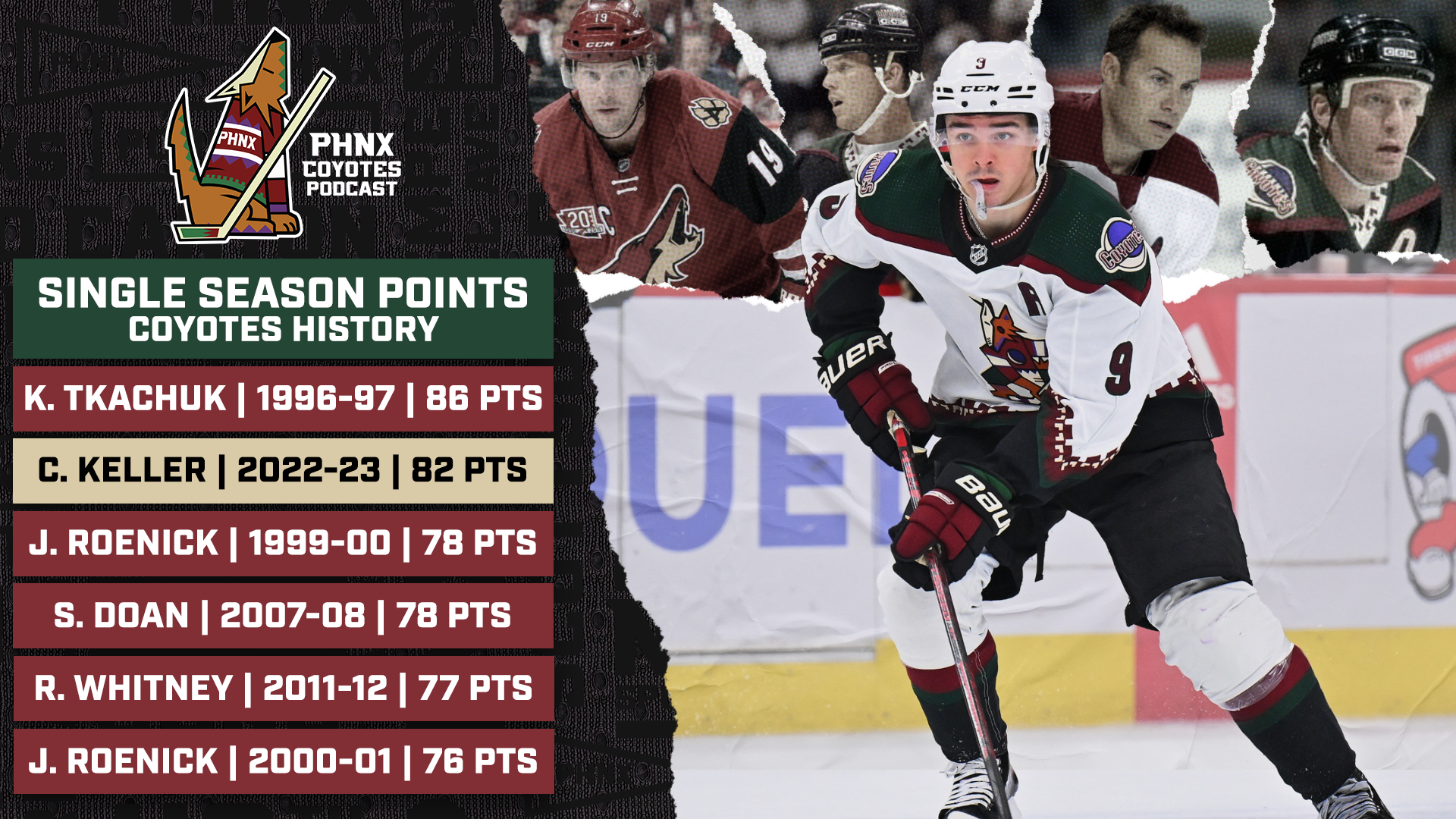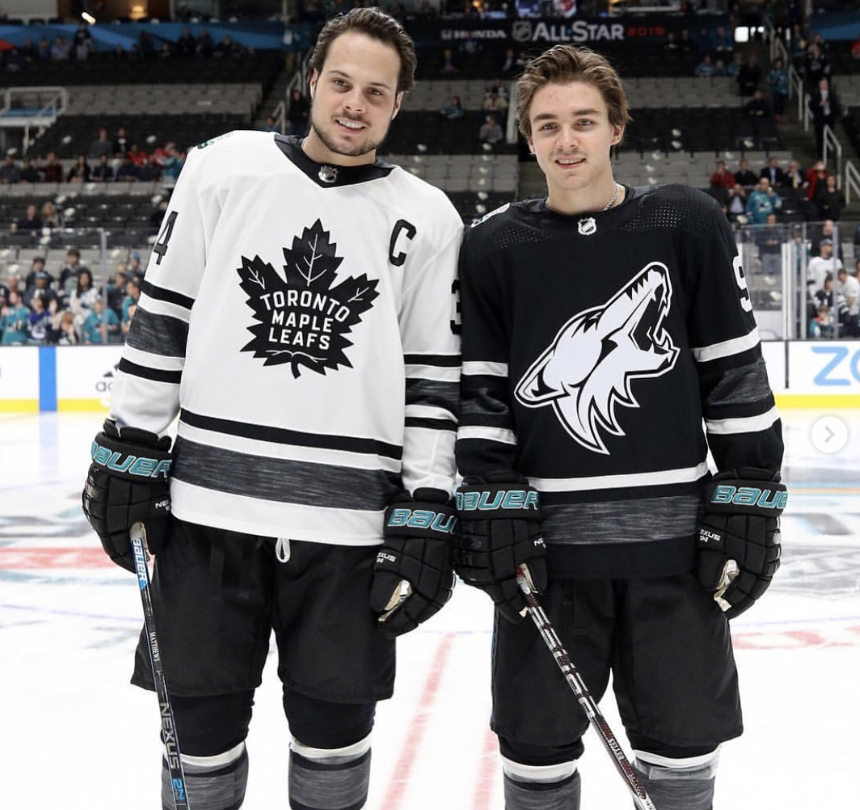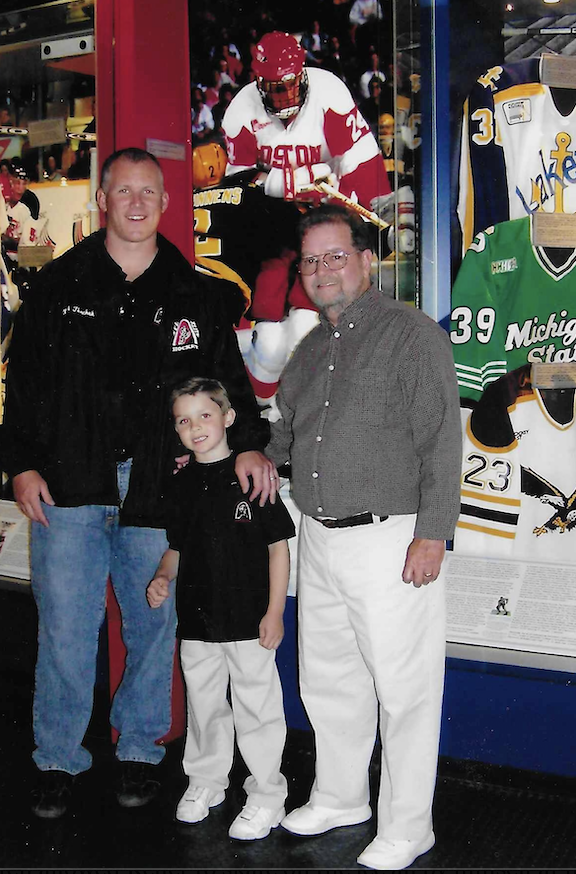© 2025 ALLCITY Network Inc.
All rights reserved.

When Clayton Keller reached the medical room at Gila River Arena shortly after breaking his right femur in two clean pieces, the first thing that he asked the team’s orthopedic surgeon, John Tokish, was this: “Will I be able to play again?”
Keller’s evolution into a bona fide NHL superstar didn’t begin that night. That process began as a child whom Keith Tkachuk said “just lived and breathed hockey.” It was nearing fruition when he crashed into the end boards almost exactly one year ago. But when the future of his all-consuming passion was threatened, that existential crisis shifted Keller into an even higher gear — one reserved for a select few athletes.
“I had never missed any time,” said Keller, who had a perfect NHL attendance record before the injury. “I’d never not been able to play the game and then all of the sudden, I couldn’t do the things that I wanted to do. I couldn’t get out of bed. I couldn’t stand up on my own. I couldn’t get dressed. I was so lucky to have my mom [Kelley] there for the majority of the time because the first couple of days were just a lot of pain.
“I think for a lot of players, hockey is most of our lives and when it’s taken away from you, you kind of put things in perspective and realize just how special and lucky we are to play this game and play it at a high level. My dad [Bryan] always told me, ‘Play every shift like it’s your last’ and that stuck with me. I think realizing that it can be taken from you at any second is kind of what helped me push through it and maybe focus on my game even more.”
At some point over the season’s final five games, Keller is probably going to break Keith Tkachuk’s single-season Coyotes franchise points record of 86. He sits at 82 after his 14-game point streak was snapped on a disallowed goal in Saturday’s loss to San José.

It’s a stunning about-face for a player whose eight-year, $57.2-million contract extension was once described by multiple league executives as an albatross. In becoming just the second Coyote ever to eclipse the 80-point barrier, Keller is making a strong case for the label of best draft pick in the franchise’s Arizona history.
It’s not just the production that has elevated Keller to elite status, however. It’s the two-way game that coach André Tourigny demands of him. It’s his ability to play in all situations. It’s his leadership, embodied in his vocal bench demeanor late in games. It’s his increasing comfort in his own skin when dealing with media or chirping GM Bill Armstrong.
It’s that esoteric ability that analysts always tout as the ultimate measure of an elite athlete: Keller is making everybody around him better, whether it’s two-year running mate Nick Schmaltz, center Travis Boyd, who set career highs in goals and points last season, or Keller’s blossoming roommate and linemate Barrett Hayton.

A defining moment for Clayton Keller
The Bill Masterton Memorial Trophy is awarded annually to the player who best exemplifies the qualities of perseverance, sportsmanship and dedication to hockey. No candidates have been announced yet, but Keller’s perseverance through a gruesome injury is obvious, and if there is a player more dedicated to his craft than Keller, they should probably check themselves into hockey rehab.
Keller wasn’t just focused on rehabilitating his leg once his doctors told him that he would enjoy a 100-percent recovery after surgery. He was focused on every aspect of performance under the sun. Aside from his work with the Coyotes staff, he did Zoom sessions three times per week with Toronto-based movement specialist Lisa Schklar. He did Eldoa sessions with New York-based strength and conditioning coach Ben Velasquez. Both of those came via the recommendation of chiropractor and soft tissue specialist Mark Lindsay, who worked with Connor McDavid after he sustained a major knee injury on April 6, 2019, in Calgary.
Keller also flew treatment specialist Ellen Spicuzza — a longtime friend from his days at Boston University — in from Boston to take the reins when Kelley Keller could not be with him. He did sessions with Scottsdale-based occupational therapist Darleen Santore, whom he calls his mental coach. And he resumed work with a strategy coach whom he had hired one year earlier.
All of these sessions were on his own dime. This summer wasn’t just about getting healthy. This summer was about getting better.
“His mental toughness is probably the part I’m most proud of because I know what had to be going through his mind immediately after the injury and the surgery,” Bryan Keller said. “I know that he was determined to work his way back but I’m sure there was a lot of doubt in his own mind until he got going.
“He had to wait a couple of days to start physical therapy, but once he was on the walker, he goes, ‘I’ll be skating in six weeks.’ And then once he started skating, he had already set a goal that he would be ready for opening night, which he was.”
Former Coyote Conor Garland is well-known for his detailed and fascinating offseason projects, but Keller took a more academic approach; a blend of sound methodology and cutting-edge research. In the past, he was criticized for playing too much on the perimeter. There was a reason for that tactic, but the game that everyone is watching now is a refined version that combines Keller’s strengths with elements required for NHL success.
“A lot of skill coaches will look at the biomechanics of players like Clayton, but I didn’t do that and I think that’s what really intrigued him because I wasn’t trying to transform his body or get him to do things that he doesn’t naturally do,” said Keller’s strategy coach, who preferred to remain anonymous. “Clayton is a puck manager. He’s a quarterback, first and foremost. So what I looked at first were his multiple puck touches per offensive zone sequence.
“The number was really high. That can be a good thing or it can be a bad thing. In his case, it wasn’t great because he was getting a lot of heavily contested pucks. At his size, he can’t do much with heavily contested pucks besides just move on the outside a lot so I thought, ‘How can we help Clayton get more pucks in space?’ Because when he has pucks in space, he can really do what he needs to do to generate and create.”
The pair watched videos of three-time Stanley Cup winner Patrick Kane — a player whom Keller has always tried to emulate — to see what makes him successful.
“What Kane does is he creates predictability,” the strategy coach said. “He’ll be in the open corner or he’ll skate high outside the zone, but it’s not just about doing those things. It’s about the timing. What are you reading? What cues are you taking from the defense that will allow you to get the puck in space; to get pucks inside defensive rotations?”
Once Keller got back on the ice, he began implementing some of these ideas with the strategy coach. He also brought in teammates like Schmaltz, Hayton, and even Auston Matthews, who always skates in his home state of Arizona during the summer, to work on these concepts.
Schmaltz was injured in the first game of the season at Pittsburgh, but once he returned to the lineup, he and Keller were able to take their chemistry to another level. Hayton joined the two around the midway point of the season and has since produced 24 points in 27 games since the All-Star break. Together, they’ve formed one of the NHL’s most productive lines.

“You guys probably know from watching us, but we like to be in motion all the time,” Schmaltz said. “If we’re moving our feet, it’s tough to defend us. When the defense is coming off the point and the forwards are rolling over the top, it’s tough to defend because you don’t really know where your guy is. We just try to do a lot of movement, rotation, and rolling off each other to create havoc with the defensive zone coverage for teams.
“If I’ve got the puck rolling off the wall and Kells comes behind, I try to get a little pick on the guy that’s covering Kells. Then I roll off him, and he hits me. It’s a lot of give-and-gos, and we try to play high in the ice a lot because I think it’s hard for forwards if you’re trying to cover a guy up top and your defenseman rolls down. It gets really confusing.”

An altered perception of Clayton Keller
When former Coyotes GM John Chayka signed Keller to an eight-year contract extension with an average annual value (AAV) of $7.15 million in September 2019, the deal raised eyebrows across the league. The contract did not kick in for another year, but Keller was coming off a 47-point season, and almost every corner of the NHL universe thought Chayka had overpaid.
“We’re looking to build out a core with players that can be around for a long time,” Chayka reasoned at the time. “When you’ve got players with whom you feel that’s the case, as you wait, it just gets more expensive. That’s just the nature of the salary cap increasing and more cap getting allocated to young players. If there’s an opportunity to be proactive, that is what we have looked to do.”
The NHLPA told Keller’s agent Scott Bartlett then that it was the largest AAV ever handed out after a 47-point season. PHNX Sports reached out to several sources last week, including Cap Friendly, Puck Pedia, and a pair of NHL cap specialists, to ask a question: If Keller were on the open market now, what would he be worth? While not deeply researched, the answer was anywhere from $8.5 million to $9.5 million per year.
“For any young player, you want to position yourself to have enough security that you don’t ever have to work again because there’s things out of your control; you are one injury away,” said Bartlett, citing Keller’s leg surgery as an example. “As we were negotiating, the total dollar figure got to the point where it was really appealing and Clayton had not had his best season, so it was a really intriguing package. We felt that although he might be underpaid toward the back end of it, once we got up into the sevens, we didn’t think it was going to be egregious enough where it was going to be something like Nathan MacKinnon, who is underpaid by half. We felt the security-to-upside metric was appropriate.”
“Ultimately, we don’t make decisions for our clients, but that’s what Clayton and his family wanted to do; lock in, so that’s what we did. Full credit to John Chayka, honestly, as far as understanding what Keller’s potential and growth would be. More important than any on-ice attribute, I think it really relates back to understanding who Clayton is as a person and understanding his drive and believing in it.”
Keller knew what critics were saying about him. He knew that they doubted his defensive commitment. He knew that they felt he was a soft, perimeter player. He knew that they doubted his leadership abilities.
Several years ago, he addressed all of the critics in one succinct quote, promising that one day he was “gonna shove it up their ass.”
The proof is in the performance. Keller entered Sunday’s games ranked among the league’s top 20 in goals and points. His 16 third-period goals ranked in the top 10. His 35 primary assists rank tied for ninth in the NHL and represent an astounding 76 percent of his assist total. Since the All-Star Game, he is fourth in the NHL in points (41) behind McDavid, Edmonton’s Leon Draisaitl, and Colorado’s Nathan MacKinnon.
The performance is all the more impressive when you consider the magnitude of the injury and the fact that Keller hasn’t had any rest. Between rehab, training, and the season, he has been going nonstop since the start of the 2021-22 season. Of all the players who could have used a rest at the All-Star break, Keller topped the list, but he flew across the country to south Florida, represented the Coyotes for the third time in his career, spent time with his family, and got “like two days off total” before the season resumed.
In spite of that, his production has actually increased since the All-Star break.
“I’ve learned over the years to have a short memory,” Keller said. “I’ve learned to deal with bad stretches better. I wasn’t so hard on myself. Even this year, there were a couple of stretches where the pucks weren’t going in and you’re not getting the bounces, but I think I did a good job of just sticking with it and not changing my game; not cheating by trying to create offense the wrong ways. I stuck to the plan.”
There is a cockiness to Keller that serves him well; one that you will often find among elite athletes. Until recently, however, it was misunderstood because he was not comfortable in media interactions. He was sparse with his words, seemingly closed off to further insight, and when he did speak, he often did so in safe clichés, leading many to wonder who the real Clayton Keller was.
“I think that might be a bit more for you guys on your side of things than it is for us,” said his roommate, Barrett Hayton. “When you become close with him, you really get to see his personality and the type of guy he is. Everyone understands his passion and what he puts into the game, but over the last two years, I think he’s really taken the next step on vocally leading the guys and that’s really been an important part of our team this year.”

Keller has a heart-warming relationship with Hayton that he describes as equal parts big brother, mentor, and friend.
“Sometimes, I give him shit at home when he’s leaving stuff around the kitchen or leaving his shoes in front of the door, but Barrett is actually a great roommate,” Keller said, laughing. “He’s really clean, which is important.”
Hayton also shares Keller’s singular focus for the profession of hockey; a focus which Bartlett describes as “an obsession with the game.”
Keller isn’t much of a night owl. Bryan Keller notes that his son doesn’t drink much or party into the wee hours. Aside from his other passion, golf, Keller is mostly a homebody who spends his time eating the food that his personal chef makes, playing with the dog that he bought while he was injured, watching Netflix series such as “Full Swing” and “Break Point,” or battling Hayton in hoops, cards, ping pong or on the chipping area in his backyard.

“We definitely spend a lot of our time out there,” Keller said of the chipping area. “On [Wednesday] night, we were out there for like two hours. We always compete and play against each other and get in arguments over who’s closer to the flag.”
Hayton freely admits what many other Coyotes teammates (aside from Phil Kessel) have already admitted.
“The rumors are true, he is a really good golfer,” Hayton said, laughing. “He spends a lot of time around here in the summers so he’s played with some [PGA] Tour players.
“Honestly, he’s just good at everything so it’s always a fight. Like, he’s even really good at ping pong.”

Clayton Keller is chasing history
Tkachuk marvels at what Keller is doing, but not because he ever doubted that his former pupil would achieve this level of production.
“The one surprise I do see is how well he’s responded from the injury,” Tkachuk said. “I think it’s amazing how much time and effort this kid has put in to get back to where he is, and even beyond where he was before.
“The puck follows him. That’s what all good players have in common, but then his skill level is off the charts, his stick handling and his vision are elite, and he’s smart. He doesn’t put himself in a position where he’s gonna get hit hard. Good players know where the puck is going to be, so he’s two steps ahead of a lot of players. That’s what makes him so successful.”
When Tkachuk retired, he settled near his last NHL stop, St. Louis, which is where Keller grew up. Along the way, he coached Keller in two separate seasons, while Keller played up an age group with Matthew Tkachuk, and later, Brady Tkachuk played up with Keller.
“The kid is determined and he was no different when he was 10 years old than he is now,” Tkachuk added. “We’d go to tournaments where we had a good team, but he always kind of rose above everybody else while people were saying he was too small.
“It’s crazy to look at these kids now. I remember them when we were staying at shitty hotels, eating shitty food and now all these guys are making seven-, eight-plus million a year. It’s crazy, but I’m happy for them. They’re living their dream.”
As he has matured, it has become evident that Keller has grown more comfortable in his skin. He fires pucks at reporters standing along the glass for practice at the Ice Den. He cracks jokes and he even chirps his rebuild-focused GM when he comes off the ice after wins that are lowering the Coyotes’ odds of landing top overall pick Connor Bedard.
“When you’re a little bit younger, it’s a different situation. There are veterans around so maybe you don’t feel like it’s your place to be as vocal,” Keller said. “I still think I have a ways to go, but I’m vocal when the time is right. It’s not to hurt feelings or anything like that. It’s just that I want the best for our team and for the players as well.”
Coach André Tourigny has seen that in spades this season.
“He has a little bit of Michael Jordan in him, or Sidney Crosby,” Tourigny said. “He doesn’t go out there to just try to be alright. He demands excellence from himself, he’s really tough on himself and he wants everybody to make plays. Sometimes players will not make a play and he will be hard on them.
“He’s the kind of a guy who’s not passive in any situation. He’s not sitting back and leaving any stone unturned. He will talk a lot on the bench and to players. ‘Hey, cut here. Open ice there. Give me the puck.’ He’s a guy who really is proactive on what we have to do and how we have to play.”
Tourigny has espoused the idea of a leadership group rather than a single captain, and for the past two seasons, nobody has worn the C. Tourigny has left open the possibility of somebody grabbing those reins. Keller’s ascension puts him in play for the honor that his St. Louis mentor, Tkachuk, first wore for the Coyotes.
“I would love to wear it, but there’s still another step of leadership that I need to take in order for me to feel comfortable with that,” he said. “To be a good captain, I think you have to take small steps and keep heading in that direction. It’s just such an honor to be captain in this league so it’s not something you can take lightly, and we do have a great leadership group now so I don’t think it’s anything that’s lacking here.”
What’s lacking for the team is on-ice success. Keller understands that the organization’s focus is on rebuilding through the draft, but he doesn’t want to accept the idea of the Coyotes becoming a weigh station for players on their way to another franchise.
“The guys that are here want to be here,” he said. “Obviously, there’s a lot of noise off the ice with our team and this organization, but we’ve just stuck together. We want to show them that we can do something with our core and the guys that are here now and want to be here. These last two years, I do think we’ve taken a step. We want to take another step in these last few games and then bring it on into next year.
“It’s definitely a unique situation here with the rebuild. It’s good and bad that we have a young team and we had to learn through those struggles how to play the right way. We’re out of the playoffs, but we’re playing McDavid, MacKinnon, [Cale] Makar, [Mikko] Rantanen, unbelievable players. One day, we’re gonna have to go against them and beat them, so why not play like it now instead of just saying, ‘When the day comes, it will be time to turn it on?’
While some have speculated about his future in Arizona, in light of the rebuild timeline and the recent departure of Jakob Chychrun, Keller hopes to be around for that day when the Coyotes emerge as a contender.
“Definitely,” he said. “Obviously, we’ll have talks after the season and see where the direction of our team is going, but I love Arizona. I love the people, the coaches, the trainers. I think it’s just such a unique and special group here that I want to see do well and I don’t necessarily want to just go somewhere else because things aren’t moving how I want them to move or as fast as I want. I just take it day by day and management can figure out the rest.”
Top photo of Clayton Keller via Getty Images
Follow Craig Morgan on Twitter
Comments
Share your thoughts
Join the conversation



